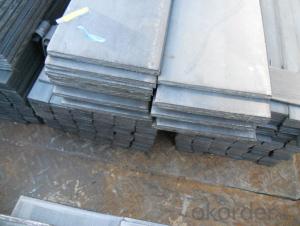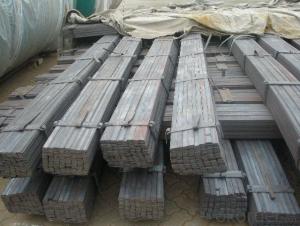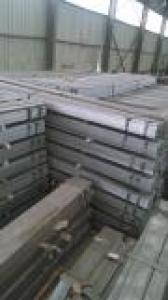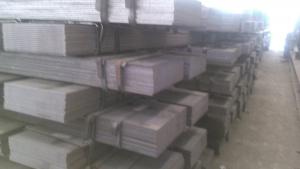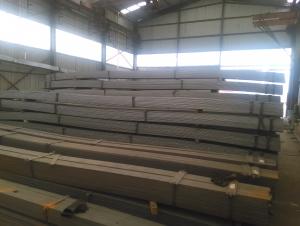Hot Rolled Steel Flat Bar with Good Price
- Loading Port:
- Tianjin
- Payment Terms:
- TT OR LC
- Min Order Qty:
- 25 m.t.
- Supply Capability:
- 10000 m.t./month
OKorder Service Pledge
OKorder Financial Service
You Might Also Like
Product Description:
OKorder is offering high quality Slit Cutting Flat Bar at great prices with worldwide shipping. Our supplier is a world-class manufacturer of steel, with our products utilized the world over. OKorder annually supplies products to European, North American and Asian markets. We provide quotations within 24 hours of receiving an inquiry and guarantee competitive prices.
Product Applications:
Slit Cutting Flat Bars are ideal for structural applications and are widely used in the construction of buildings and bridges, and the manufacturing, petrochemical, and transportation industries.
Product Advantages:
OKorder's Slit Cutting Flats Barare durable, strong, and resist corrosion.
Main Product Features:
· Premium quality
· Prompt delivery & seaworthy packing (30 days after receiving deposit)
· Corrosion resistance
· Can be recycled and reused
· Mill test certification
· Professional Service
· Competitive pricing
Product Specifications:
Manufacture: Slit Cutting
Grade: Q195 – 235
Certificates: ISO, SGS, BV, CIQ
Length: 6m – 12m, as per customer request
Packaging: Export packing, nude packing, bundled
Chemical composition of Q235
Alloy No | Grade | Element(%) | ||||
C
| Mn
| S
| P
| Si
| ||
Q235
|
B
|
0.12—0.20 |
0.3—0.7 |
≤0.045 |
≤0.045
|
≤0.3
|
Physical properties of Q235
Alloy No | Grade | Yielding strength point(Mpa) | Tensile strength (Mpa) | Elongation after fracture(%) | ||||||
Thickness (mm) | Thickness (mm) | |||||||||
≤16 | >16--40 | >40--60 | >60--100 | ≤16 | >16--40 | >40--60 | >60--100 | |||
≥ | ≥ | |||||||||
Q235 |
B |
235 |
225 |
215 |
205 |
375--500 |
26 |
25 |
24 |
23 |
FAQ:
Q1: How soon can we receive the product after purchase?
A1: Within three days of placing an order, we will begin production. The specific shipping date is dependent upon international and government factors, but is typically 7 to 10 workdays.
Q2: How do we guarantee the quality of our products?
A2: We have established an advanced quality control system which conducts strict quality tests at every step, from raw materials to the final products. At the same time, we provide extensive follow-up service assurances as required.
Q3: The products are invoicing on theoritical weight or actual weight?
A3: We can do it in both manners, it 's according to the customers' requirements.
Images:
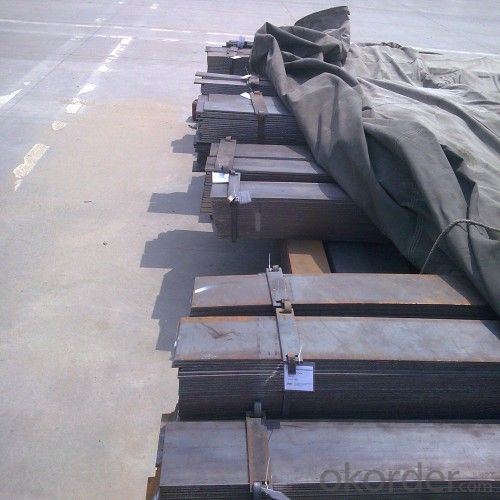
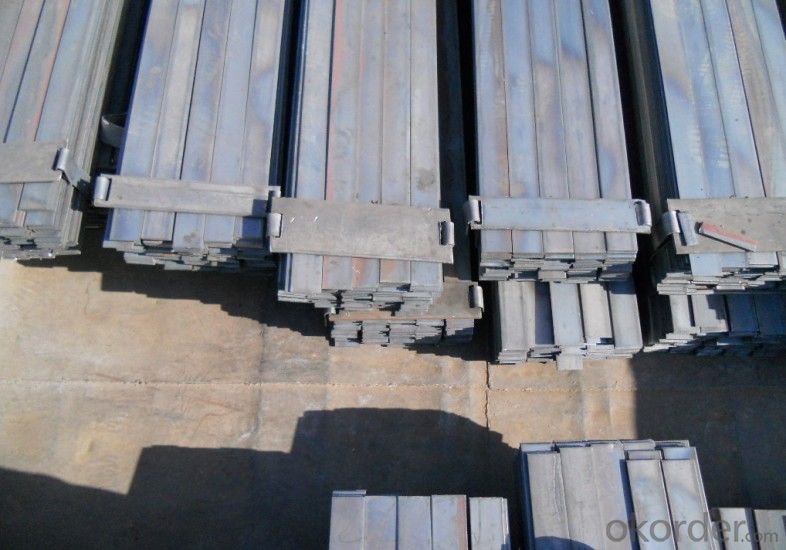
- Q:What are the different types of edge finishes available for steel flat bars?
- There are several different types of edge finishes available for steel flat bars, depending on the desired aesthetic and functional requirements. Here are some of the most common types: 1. Square Edge: This is the most basic and simple edge finish, where the edges are left untouched and remain square in shape. It is commonly used for structural applications or when the appearance is not a significant factor. 2. Rounded Edge: Also known as a radius edge, this finish involves rounding off the sharp edges of the flat bar. It provides a smoother and more visually appealing appearance while also improving safety by reducing the risk of injury from sharp edges. 3. Beveled Edge: In this finish, the edges of the flat bar are cut at a specific angle, usually at 45 degrees. Beveled edges are often used in applications where two flat bars are joined together at a specific angle, creating a clean and precise joint. 4. Rolled Edge: This type of finish involves rolling the edges of the flat bar to create a curved or rolled appearance. Rolled edges are commonly used for decorative purposes, as they add a unique and stylish touch to the flat bar. 5. Serrated Edge: A serrated edge finish features small notches or teeth along the edges of the flat bar. This type of finish is often used in applications where enhanced grip or traction is required, such as grating or flooring. 6. Chamfered Edge: Chamfering involves cutting a beveled edge along the length of the flat bar, rather than just at the ends. This finish is commonly used to remove sharp corners and make it easier to handle the flat bar. These are just a few examples of the different edge finishes available for steel flat bars. The choice of edge finish will depend on factors such as the intended use, aesthetic preferences, safety requirements, and cost considerations.
- Q:Can steel flat bars be cold worked or hot worked?
- Steel flat bars can be both cold worked and hot worked, depending on the desired outcome. Cold working refers to the process of shaping or forming the steel at room temperature through techniques such as rolling, bending, or drawing. This method is commonly used to improve the strength and hardness of the steel, as well as to achieve precise dimensions and smooth surfaces. On the other hand, hot working involves shaping or forming the steel at elevated temperatures, typically above its recrystallization temperature. This process allows for greater plasticity and easier deformation of the steel. Hot working methods include forging, extrusion, and hot rolling. It is often used to produce complex shapes, reduce internal stresses, and enhance the material's grain structure. The choice between cold working and hot working steel flat bars depends on various factors, such as the desired mechanical properties, the complexity of the shape, and the equipment and resources available. Cold working is generally preferred for smaller-scale operations and when precise dimensions and surface finish are crucial. Hot working is more suitable for larger-scale production and when the steel needs to be shaped into intricate or complex forms.
- Q:What are the different types of steel flat bar finishes for architectural purposes?
- For architectural purposes, there exist numerous steel flat bar finishes that are commonly utilized. These finishes serve to enhance the visual appeal of the steel flat bar and guard against corrosion. One well-liked finish is the plain or mill finish, which denotes the untreated surface of the steel. This particular finish is commonly employed in industrial or utilitarian settings where appearance is not of utmost importance. Another frequently used finish is the brushed finish, otherwise known as the satin finish. Achieved through the use of abrasive materials to brush the steel surface, this finish results in a textured and slightly reflective appearance. Brushed finishes are often favored in modern and contemporary architectural designs. For steel flat bars, a polished finish is also an option. This finish involves grinding and polishing the steel surface to create a smooth and reflective appearance. Particularly preferred in high-end architectural projects, polished finishes impart a luxurious and elegant look. To protect against corrosion, a galvanized finish can be applied to the steel flat bar. This finish entails immersing the steel in molten zinc, which forms a protective layer on the surface. Galvanized finishes are commonly employed in outdoor architectural applications, such as fences, handrails, and building facades. Lastly, a powder-coated finish is another possibility. It involves applying a dry powder to the steel surface and subsequently curing it under heat. This finish provides a durable and decorative coating, available in a wide range of colors and textures. Powder-coated finishes are often utilized in architectural projects where color customization is desired. In summary, the various steel flat bar finishes for architectural purposes encompass the plain or mill finish, brushed finish, polished finish, galvanized finish, and powder-coated finish. Each of these finishes possesses distinctive characteristics and advantages, enabling architects and designers to achieve their desired aesthetic and functional objectives.
- Q:How are steel flat bars stored or transported?
- Steel flat bars are typically stored in bundles or stacks in warehouses or storage yards. They are often bundled together using steel straps or wires to prevent them from shifting during transportation. When transported, flat bars are loaded onto trucks or trailers and secured with straps or chains to ensure they remain in place during transit.
- Q:What is the typical width tolerance for steel flat bars?
- The typical width tolerance for steel flat bars can vary depending on the specific grade and manufacturing process, but it is generally within a range of +/- 0.005 to 0.03 inches.
- Q:What is the maximum length-to-thickness ratio for steel flat bars?
- The maximum length-to-thickness ratio for steel flat bars is typically around 200:1.
- Q:How do I determine the strength of a steel flat bar?
- To determine the strength of a steel flat bar, you need to consider its grade, which indicates the alloy composition and mechanical properties of the steel. The grade is usually marked on the bar or can be obtained from the manufacturer's specifications. Additionally, you can refer to industry standards or consult engineering handbooks that provide information on the strength and properties of various steel grades.
- Q:What is the difference between hot-rolled and cold-drawn steel flat bars?
- Hot-rolled and cold-drawn steel flat bars are both widely used in various industries, but there are key differences between them. Hot-rolled steel flat bars are produced by heating a billet or slab of steel to a high temperature and then rolling it into the desired shape, such as a rectangle or square. This process allows for larger sizes and quantities to be produced quickly and efficiently. Hot-rolled steel bars have a rougher surface and may have mill scale or a slight oxide layer due to the high temperature involved in the manufacturing process. On the other hand, cold-drawn steel flat bars are created by pulling a hot-rolled steel bar through a die at room temperature. This process helps to improve the dimensional accuracy, surface finish, and mechanical properties of the steel. Cold-drawn steel bars have a smoother surface and tighter tolerances compared to hot-rolled bars. They also have a higher yield strength and tensile strength, making them suitable for applications that require enhanced strength and precision. Due to their different manufacturing processes, hot-rolled steel flat bars are generally more cost-effective and readily available in larger sizes and quantities. They are commonly used in construction, manufacturing, and general fabrication applications where surface finish and tight tolerances are less critical. In contrast, cold-drawn steel flat bars are preferred for applications that require higher precision, tighter tolerances, and improved mechanical properties. They are commonly used in industries such as automotive, aerospace, and machinery manufacturing, where strength, dimensional accuracy, and surface finish are crucial factors. In summary, the main differences between hot-rolled and cold-drawn steel flat bars lie in their manufacturing processes and resulting properties. Hot-rolled bars are cost-effective and readily available in larger sizes, while cold-drawn bars offer improved precision, tighter tolerances, and enhanced mechanical properties. The choice between the two depends on the specific requirements of the application and the desired balance of cost, strength, and surface finish.
- Q:What is the maximum width of a steel flat bar?
- The specific manufacturing process and desired application can cause variations in the maximum width of a steel flat bar. Typically, steel flat bars are available in widths ranging from 1/8 inch to 12 inches, although certain specialty manufacturers might offer wider alternatives. To ascertain the precise maximum width for a particular type of steel flat bar, it is essential to consult with a steel supplier or manufacturer.
- Q:Galvanized flat steel how much is one meter?
- The price of galvanized flat steel is about 6200, so the price is 40 * 4 * 0.00785 * 1.06 * 6.2=8.3 yuan per meterGalvanized pipe price is about 6500, DN25:2.57 * 6.5=16.7 yuan / meter, DN32:3.32 * 6.5=21.58 yuan / meterAngle steel price 5000, 4# angle steel: 2.422 * 5=12.1 yuan / meter
1. Manufacturer Overview |
|
|---|---|
| Location | |
| Year Established | |
| Annual Output Value | |
| Main Markets | |
| Company Certifications | |
2. Manufacturer Certificates |
|
|---|---|
| a) Certification Name | |
| Range | |
| Reference | |
| Validity Period | |
3. Manufacturer Capability |
|
|---|---|
| a)Trade Capacity | |
| Nearest Port | |
| Export Percentage | |
| No.of Employees in Trade Department | |
| Language Spoken: | |
| b)Factory Information | |
| Factory Size: | |
| No. of Production Lines | |
| Contract Manufacturing | |
| Product Price Range | |
Send your message to us
Hot Rolled Steel Flat Bar with Good Price
- Loading Port:
- Tianjin
- Payment Terms:
- TT OR LC
- Min Order Qty:
- 25 m.t.
- Supply Capability:
- 10000 m.t./month
OKorder Service Pledge
OKorder Financial Service
Similar products
New products
Hot products
Hot Searches
Related keywords
